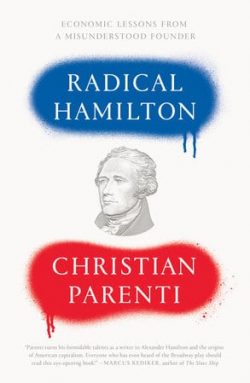In his new book Radical Hamilton: Economic Lessons from a Misunderstood Founder, Christian Parenti wants to resurrect Alexander Hamilton to fight climate catastrophe using the concentrated power of the capitalist state. Rather than a propagandistic folk hero in a manner of the Broadway hit, Parenti attempts to reframe Hamilton as an eco-warrior whose 1790s financial plan is a “greener means proper” (p. 237). Conscious of Hamilton’s role as the architect of US state capitalism, and ultimately, the global capitalist hegemon, Parenti’s judgement is clouded by a desperate search for state intervention to reverse climate catastrophe.
There is much that Parenti gets right. Hamilton’s financial plan established a strong state that could set up, run and protect a national capitalist economy. Few have explored the monumental extent of Hamilton’s theory of political economy as thoroughly as Parenti, and he’s dead on in recognizing Hamilton’s central role in the design of the capitalist state and ultimately world empire. Setting up an integrated and productive capitalist economy required a stable state that could issue a reliable currency, a dependable financial system that could generate investment capital, protection of private property with a robust military, and a national tax system to finance it all. Parenti is correct that in generating the foundational myths of American “free market” ideology Hamilton has been somehow transformed into something he wasn’t. At the beginning there was the state, and the state set up and nurtured the fledging capital economy. As Parenti explains so well, because “capitalism is produced and reproduced by the state” all US capitalists practice a sort of “bastardized Hamiltonianism” (p. 174).
But here we depart ways. Hamilton sought the concentration of economic and political power in the new federal government established by the US constitution not as an “anti-imperialist” proto-dependency theorist, as Parenti asserts (p. 5). Rather, he concurred with Madison that the only path for the survival of the fledgling national capitalist class was a strong state that could vanquish the growing power of an organized and armed working class of small subsistence farmers, seditious soldiers, laborers, rebellious slaves, and powerful native peoples.
As this motley crew gained ground in its assault on many of the state governments, mercantilists and slaveocrats found their plans threatened. Paper money was widespread, creditors were weakened, slaves were increasingly engaged in open rebellion, and waged workers were scarce, expensive, and beginning to form unions and “strike with their feet,” leaving for cheap land stolen from native peoples.
While Parenti recognizes this array of class struggles in chapters 7, 8, and 9, he appears to miss entirely that the constitution was explicitly designed to thwart it both politically and economically. Parenti’s focus on “what the government was empowered to do, rather than how the government was designed to function” is only half the story (italics added, p. 126). How the US constitution established an undemocratic system is worthy of analysis, not only to assess the outcome of 1787, but to understand how it was intentionally designed to preclude any other possible outcome. In short, the framers designed the federalist system both to impede democratic control of the polity and prevent democratic control of the economy.
The powerful developmentalist state Parenti admires is not only the primary impediment to reversing climate catastrophe; it is the very cause of two key problems. The developmentalist state is the reason for both why we have yet to do anything about climate catastrophe and why we will not be allowed to use the state to intervene to “deindustrialize” from fossil fuel use and pursue the “green industrialization” he advocates. (p. 237) Parenti’s logic flaw of excluding the how the government was designed to function is fatal to his analysis of the what.
The reason for this analytical flaw is both complex and simple. The US constitution is a well disguised constitution for capital. It is certainly the case that we sometimes deploy the constitution in struggles to contain, or infrequently and temporarily reverse, the worst excesses of capitalism. Yet, the very rules of the system foreclose all but minor temporary pyrrhic victories. That is because the state was designed not only to protect and promote property, slaves, debts, land, and other tangible property, but to tie the hands of those who would seek to transform the relations of production by using the state to carry out an assault on all property. This is where liberal Supreme Court Brennan’s “counter-majoritarian difficulty” merges with Justice Scalia’s “originalism” in protecting property. The complex array of checks and balances and separation of powers in the “federalist” system are quickly transformed into minority checks that give the upper hand to elites to stop change sought by the economic majority or spike it by a death of a thousand delays.


